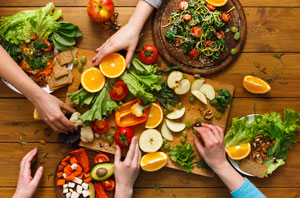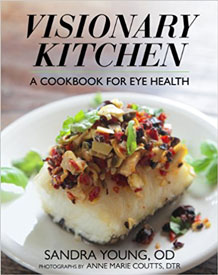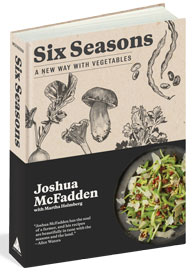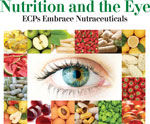 Let’s face it, winter was a long, sloggy, cold mess this year, especially in the Northeast. Now that spring has sprung, everyone’s thinking about righting some of those wrong winter habits (overeating, binge-watching Netflix) and changing their unhealthy ways. Naturally, spring is when people’s thoughts turn to the outdoors and having a healthy, active lifestyle is top of mind. Spring is also the perfect time for eyecare professionals to educate patients on how to eat healthier and take care of their eyes at the same time.
Let’s face it, winter was a long, sloggy, cold mess this year, especially in the Northeast. Now that spring has sprung, everyone’s thinking about righting some of those wrong winter habits (overeating, binge-watching Netflix) and changing their unhealthy ways. Naturally, spring is when people’s thoughts turn to the outdoors and having a healthy, active lifestyle is top of mind. Spring is also the perfect time for eyecare professionals to educate patients on how to eat healthier and take care of their eyes at the same time.
Linda Hardy, LDO, is a contributor to Pro to Pro, 20/20’s go to resource for education geared toward eyecare professionals. Her recent article, “Healthy Eating Equals Healthy Eyes” extolled the virtues of living a cleaner life. She writes, “It is well known that exercising and discontinuing bad habits such as smoking and drinking alcohol will help us live a healthier life. Eating healthy foods is a big part of that healthy lifestyle—not only will it improve your overall health, but there are some vitamins and minerals that can have a direct effect on healthier vision.”
Based on Hardy’s recommendations, here are some quick tips about the link between nutritious food and better vision that ECPs can share with patients:
 Beta-carotene is an antioxidant carotenoid that converts to vitamin A in the body. Vitamin A helps the surface of the eye, mucous membranes and skin to be effective barriers against bacteria and viruses, reducing the risk of eye infections and other infectious diseases. Foods that contain beta-carotene are carrots, sweet potatoes, apricots and cantaloupe.
Beta-carotene is an antioxidant carotenoid that converts to vitamin A in the body. Vitamin A helps the surface of the eye, mucous membranes and skin to be effective barriers against bacteria and viruses, reducing the risk of eye infections and other infectious diseases. Foods that contain beta-carotene are carrots, sweet potatoes, apricots and cantaloupe.
Zinc is a mineral that brings vitamin A from the liver to the retina where it is used to create a pigment called melanin which protects the retina. Foods that contain zinc are legumes, black-eyed peas, kidney beans, lima beans and peanuts. Other foods high in zinc are oysters, lean beef, pork, and chicken including dark and breast meat.
Vitamin C helps support the health of blood vessels in the eye. Foods that contain vitamin C are citrus fruits such as lemons, oranges, grapefruit and tangerines. Other foods rich in Vitamin C are peaches, red peppers, tomatoes, strawberries, bok choy, cauliflower and papaya.
Lutein and zeaxanthin lower the risks of macular degeneration and cataracts. Foods that contain lutein and zeaxanthin are kale, spinach, romaine lettuce, collards, turnip greens, eggs, broccoli, peas and corn.
Vitamin E can protect cells in the eyes from damage. Foods that include Vitamin E are sunflower seeds, hazelnuts, almonds, sweet potatoes and fortified cereals.
 Eye expert Sandra Young, OD, has written two books on the subject of how diet and nutrition affect ocular health. Her first book, “Visionary Kitchen: A Cookbook for Eye Health,” featured recipes that highlighted eye nutrients. According to a 2014 feature that appeared in Women in Optometry Young attended a meeting of the Ocular Nutrition Society in 2011 and realized she could she combine her two passions—optometry and cooking. “The results of the AREDS studies and other research made me realize that the evidence was quite compelling that nutrition played an essential role in eye health. It was then that I discovered there were no cookbooks or other hands-on resources to get eye-nutrient-dense food from the researchers to our patients’ tables. I started out by researching specific nutrients most beneficial to ocular health, and then I came up with a list of nutrient-dense foods. From these lists, I created the recipes,” she said.
Eye expert Sandra Young, OD, has written two books on the subject of how diet and nutrition affect ocular health. Her first book, “Visionary Kitchen: A Cookbook for Eye Health,” featured recipes that highlighted eye nutrients. According to a 2014 feature that appeared in Women in Optometry Young attended a meeting of the Ocular Nutrition Society in 2011 and realized she could she combine her two passions—optometry and cooking. “The results of the AREDS studies and other research made me realize that the evidence was quite compelling that nutrition played an essential role in eye health. It was then that I discovered there were no cookbooks or other hands-on resources to get eye-nutrient-dense food from the researchers to our patients’ tables. I started out by researching specific nutrients most beneficial to ocular health, and then I came up with a list of nutrient-dense foods. From these lists, I created the recipes,” she said.
Her newest book, “Heal Your Dry Eyes,” is all about cooking with dry eyes in mind. In a recent follow-up feature in Women in Optometry she said, “There are many underlying causes of dry, irritated eyes including hormonal imbalances, medications, diabetes, allergies and arthritis. The one common factor in dry eye is ocular surface inflammation. Proper nutrition can help to modulate both ocular and systemic inflammation. The recipes in “Heal Your Dry Eyes” are designed to reduce ocular surface inflammation and to improve tear composition and production. It is preventive medicine,” said Dr. Young.
The vegetable craze has been gaining in popularity for some time now, aided by the ever expanding farm-to-table restaurant trend. You could say that Portland chef Joshua McFadden is wild about vegetables. His first cookbook, "Six Seasons: A New Way With Vegetables," recently won the James Beard Award for Best Vegetable Focused Cookbook. Following culinary school and several stints at top notch restaurants, McFadden decided to ditch the restaurant rat race and went to live on a farm in Maine for two years growing, you guessed it, vegetables. Click here for some of his signature recipes and watch the CBS This Morning interview with him below.
 Check out Vision Monday's special feature on Nutrition and the Eye to see how ECPs are embracing nutraceuticals.
Check out Vision Monday's special feature on Nutrition and the Eye to see how ECPs are embracing nutraceuticals.
How to Discuss Nutrition With Your Patients in 4 Easy Steps Ask your patients what foods are best for their eyes and they're likely to name carrots. According to the
American Optometric Association’s American Eye-Q survey, only 1 percent of people know that spinach is the best food for eye health. Talking to your patients about their eyes is easy enough but what happens when ODs veer off into other areas of health care? Here are 4 tips from the AOA on talking diet and nutrition in the exam room.
1. Make the connection.
"It can be difficult to bring up the topic of diet and nutrition in the office, especially since many patients do not make the connection between diet and ocular health," said Diane Russo, OD. I often start the conversation by linking their diet to overall health. I explain that the eyes are a part of the body and are affected by how well you take care of the body. It seems to 'click' for many patients by approaching the topic this way."
2. Don't be afraid to ask.
"I always ask about patients' weekly consumption of plant foods—especially dark green, leafy vegetables—letting them know that increased variety of plant foods is associated with lower risk of both diabetes and heart disease. I also like to ask about consumption of refined carbohydrates and added sugars, as these have been linked directly to diabetic retinopathy, macular degeneration and cataracts," said A. Paul Chous, OD.
3. Cover the essentials.
"We cover AREDS [Age-Related Eye Disease Study, sponsored by the National Eye Institute] and make specific recommendations for that patient's particular needs, keeping in mind their current medication list and medical history. I always make sure to communicate my findings and recommendations with the patient's primary care physician," said Brad Lane, OD.
4. The “.com” effect.
A 2014 Pew Research Center survey found 7 in 10 adult internet users search online for information about a range of health issues, but 9 in 10 prefer insight from health professionals over any other source. "With all the information readily available online, it is very important that patients have information based on reliable studies," Dr. Lane said.